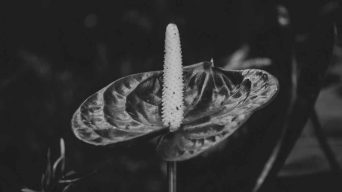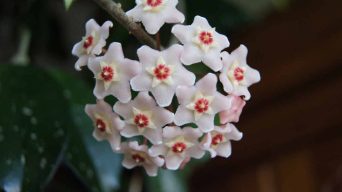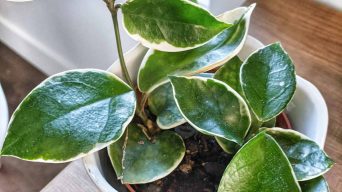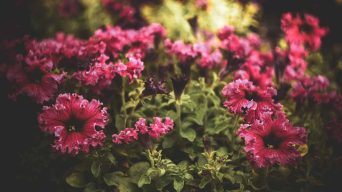Hoya plants are native to tropical and subtropical areas of Asia, Australia, and the Pacific Islands. They are popular houseplants because they are easy to care for and tolerate a wide range of growing conditions.
One of the most common problems with hoya plants is underwatering.
Although they are drought-tolerant, hoyas need a consistent supply of moisture to stay healthy. Having an underwatered Hoya is a common problem but one that is easily fixed.
Why Is Underwatering A Problem?
Underwatering is when a plant does not receive enough water.
This can be due to several reasons, such as forgetting to water the plant or the roots being unable to absorb water properly.
Water is essential for plants because it helps them to transport nutrients and minerals from the soil, provides them with support, and helps create energy and food through photosynthesis.
Underwatering can cause several problems for plants.
The Hoya leaves may droop, turn yellow or brown, and eventually fall off.
However, in severe cases, the plant may become susceptible to pests and diseases, the plant may stop growing, and the plant may die.
How Does Underwatering a Hoya Occur
There are a few different ways that underwatering can occur with Hoyas.
The most common causes are:
Incorrect Watering Practices
This is the most common cause of underwatering.
Many people don’t realize how often they should be watering their Hoya plants or think that because the plant is drought-tolerant, it doesn’t need much water.
Other times, people forget to water their plants for a week or two, and the soil becomes too dry.
Hoya plants need to be watered about once a week or when the top inch of soil feels dry.
Poor Drainage
If your pot doesn’t have good drainage, the roots of your Hoya can sit in waterlogged soil and become oxygen deprived. This will cause the roots to rot, and the plant won’t be able to take up water properly.
To fix this, you can either repot your Hoya into a pot with drainage holes or add some perlite or gravel to the bottom of your pot to improve drainage.
Incorrect Potting Mix
If you’re using the wrong potting mix, it can affect how well your plant drains and how much moisture it retains.
For Hoyas, you want to use a well-draining potting mix that contains perlite or gravel.
If your potting mix is too dense, it will hold onto too much moisture and cause the roots to rot.
Hot Weather
Hoyas will need to be watered during hot weather more often because the evaporation rate increases.
If it’s particularly hot and dry, you may need to water your Hoya twice a week.
You may also need to mist your plant more often to help it survive in hot, dry conditions.
Too Much Sunlight
Hoyas grown in direct sunlight will need to be watered more often than those grown in partial shade.
The sun will cause the soil to dry out faster, and the plant leaves will lose moisture through evaporation.
If you live in a hot climate, it’s best to grow your Hoya in partial shade to prevent it from drying out.
Root-Bound Plants
If your Hoya is root-bound, the roots have taken up all the space in the pot and are growing out of the drainage holes.
The plant will have difficulty taking up water, and the roots can start to rot. This will cause the plant to wilt and eventually die.
To prevent your Hoya from becoming root-bound, you should repot it into a larger pot every one to two years.
Pest Damage
Pests like aphids, mealybugs, and scale can suck the moisture out of your Hoya plant and cause it to wilt.
Some pests can also introduce diseases that further stress the plant and make it more susceptible to underwatering.
If you think your Hoya has pests, you should inspect it carefully and treat it with an insecticide or pesticide.
Diseases
A few diseases can damage your Hoya roots and prevent the plant from taking up water properly.
These diseases include root rot, fungal infections, and viruses.
If you think your Hoya has a disease, it’s essential to isolate the plant and treat it as soon as possible.
Otherwise, the disease could spread to your other plants and kill them.
How To Tell If Your Hoya Is Underwatered
It’s essential to be able to tell if your Hoya is underwatering so that you can take action to save the plant.
Knowing the signs of underwatering can prevent the plant from dying.
Signs of an Underwatered Hoya
There are a few telltale signs that your Hoya is underwatered:
1. Drooping Leaves
One of the first signs that your Hoya is underwatered is drooping leaves.
The Hoya leaves will start to sag and look wilted. If you touch the leaves, they will feel papery and dry.
Drooping happens because the plant is not getting enough water and cannot support the weight of the leaves.
2. Yellow Leaves
Another sign of an underwatered Hoya is yellow leaves.
The leaves will turn a pale yellow color and may start to drop off the plant.
This happens because the roots are not getting enough water to transport nutrients to the leaves.
Without these nutrients, the leaves will start to die and turn yellow.
3. Brown Leaf Edges
If the leaves of your Hoya plant have brown edges, it’s a sign that the plant is not getting enough water.
The edges of the leaves will start to turn brown and crispy.
This happens because the plant is not getting enough moisture, and the leaves are starting to dry out.
4. Leaf Drop
If your Hoya plant is dropping leaves, it’s a sign that it’s not getting enough water.
The leaves will fall off the Hoya plant easily and may drop faster than usual.
Leaf drop happens because the roots are not getting enough water to support the leaves.
Without water, the Hoya leaves will die and fall off the plant.
5. Brown Spots on Leaves
If your Hoya plant has brown spots on the leaves, it’s a sign of underwatering.
The patches will be dry and brown, and the Hoya spots may eventually turn black.
They can happen because the plant is not getting enough water or roots are starting to rot.
6. Dry and Cracked Soil
If the soil around your Hoya plant is dry and cracked, it’s a sign that the plant is not getting enough water.
When the soil dries out, it will start to crack and pull away from the sides of the pot.
This happens because the plant is not getting enough moisture to keep the soil hydrated.
7. Slow Growth
If your Hoya plant’s growth starts to slow down, it’s a sign that it’s not getting enough water.
The plant will stop growing new leaves and flowers, and the stems may start to get thinner.
This happens because the roots are not getting enough water to transport nutrients to the rest of the plant.
8. Wilted Leaves
If the leaves of your Hoya plant are wilted, it’s a sign that it’s not getting enough water.
The leaves will be soft and limp and may start to droop.
This happens because the plant is not getting enough moisture, and the leaves are starting to dry out.
9. Curling Leaves
If the leaves of your Hoya plant are curling, it’s a sign that it’s not getting enough water.
The leaves will curl up at the edges and may start to turn yellow.
This happens because the plant is not getting enough moisture, and the leaves are starting to dry out.
10. Flower Drop
If your Hoya plant is dropping flowers, it’s a sign that it’s not getting enough water.
The flowers will fall off the plant before they even have a chance to bloom.
This happens because the roots are not getting enough water to transport nutrients to the flowers.
11. Stunted Growth
If your Hoya plant’s growth is stunted, it’s a sign that it’s not getting enough water.
The plant will stop growing new leaves and flowers, and the stems may start to get thinner.
This happens because the roots are not getting enough water to transport nutrients to the rest of the plant.
How To Save an Underwatered Hoya
If you think your Hoya plant is underwatered, there are a few things you can do to save it.
1. Water Deeply and Thoroughly
The first thing you need to do is water deeply and thoroughly.
Water the plant until the soil is saturated and the water comes out of the drainage holes.
Let the plant drain for a few minutes, then empty any excess water from the saucer.
Watering deeply will help saturate the roots and ensure they’re getting enough moisture.
2. Use Room Temperature Water
Make sure to use room temperature water when watering your Hoya plant.
Cold water can shock the roots and make it difficult for the plant to absorb moisture.
If you’re unsure if your water is too cold, test it with your finger before watering the plant.
3. Mist the Leaves
In addition to watering the plant, you should also mist the leaves.
Misting the leaves will help to raise the humidity around the plant and prevent the leaves from drying out.
4. Move the Plant to a Humid Location
If your home is dry, you may need to move your Hoya plant to a more humid location.
You can put the plant in a bathroom or kitchen where there’s more moisture in the air.
You can also use a humidifier to raise the humidity around the plant.
5. Use a Humidity Tray
You can also use a humidity tray to raise the humidity around your Hoya plant.
Fill a shallow dish with gravel and water and place it under the pot.
The water will evaporate and raise the humidity around the plant.
You’ll need to regularly add water to the dish to keep the humidity high.
6. Give the Plant a Good Soak
If your Hoya plant is dried out, you may need to give it a good soak.
Fill a sink or tub with room temperature water and let the plant soak for 30 minutes.
This will help to rehydrate the roots and get the plant back on track.
7. Check the Soil
Make sure the potting soil your Hoya plant is growing in is well-draining.
If the soil is too dense, it can hold onto too much water and cause root rot.
Mixing some perlite or sand into the soil is a good idea to help with drainage.
You can also repot the plant into a well-draining potting soil mix.
8. Repot the Plant
If your Hoya plant is potbound, it may need to be repotted.
When a plant is potbound, the roots have nowhere to grow and can’t absorb enough water.
Repotting the plant into a larger pot will give the roots room to grow and make it easier for the plant to get the water it needs.
Repotting can also help refresh the potting soil and boost the plant’s nutrients.
9. Place the Plant in Bright Indirect Light
Make sure to place your Hoya plant in bright indirect light.
If the plant is in too much direct sunlight, the leaves will start to scorch.
But if the indoor plant is in too little light, it won’t be able to photosynthesize, and it will start to wilt.
10. Be Patient
It can take a while for an underwatered Hoya plant to recover.
You’ll need patience and give the plant time to rehydrate slowly.
Don’t water too frequently, as this can cause the roots to rot.
Water the plant when the soil is dry, and water deeply.
How To Prevent Underwatering a Hoya Plant
The best way to prevent underwatering a Hoya plant is to be proactive.
Here are a few things you can do to make sure your Hoya plant doesn’t get too dry:
1. Use a Moisture Meter
A moisture meter is one of the best ways to prevent underwatering.
A moisture meter will tell you when the soil is dry and when it’s time to water the plant.
This will help you know how often to water the Hoya plant and ensure it gets enough moisture.
2. Group Plants Together
Another way to prevent underwatering is to group plants together.
When you group plants, they help each other retain moisture.
This is because the plants transpire and evaporate water into the air, which then condenses on the leaves of other plants in the group.
This helps indoor plants to share moisture and stay hydrated.
3. Mulch the Soil
Mulching the soil around your Hoya plant can also help to prevent it from getting too dry.
Mulch helps retain moisture in the soil and keeps the roots cooler, preventing evaporation.
Organic mulches such as bark or wood chips are the best to use.
4. Water in the Morning
Watering your Hoya plant in the morning is the best time to water.
This is because the leaves are still wet from the dew, which will help evaporate any water that gets on them.
Watering in the morning also allows the plant to absorb water before the hot sun evaporates it.
5. Use Filtered or Distilled Water
Using filtered or distilled water is also an excellent way to prevent underwatering.
This is because these types of water don’t have any chemicals or minerals that can build up in the soil and make it difficult for the plant to absorb moisture.
6. Check the Soil First
Before watering your Hoya plant, checking the soil first is a good idea.
Stick your finger into the soil about an inch or two and feel for moisture.
If the soil is dry, it’s time to water the plant.
7. Don’t Overwater
One of the most common mistakes people make when watering plants is overwatering them.
This can lead to the plant getting too much water and causing the roots to rot.
If you think you’ve overwatered your Hoya plant, allow the soil to dry out completely before watering it again.
8. Use the Right Pot
When potting your Hoya plant, using the right size pot is essential.
If the pot is too big, there will be too much soil, and the plant will retain too much water.
If the pot is too small, the roots will be crowded and unable to absorb enough water.
It’s best to use a just big pot for the indoor plant.
9. Prune Regularly
Pruning your Hoya plant regularly is also important for preventing underwatering.
Pruning helps to keep the plant compact and allows it to use water more efficiently.
It also helps to prevent the plant from getting too big and leggy.
10. Monitor the Weather
Monitoring the weather is also important for preventing underwatering.
If you know it will be a hot and dry week, then make sure to water your Hoya plant more frequently.
You can water it less often if it’s been raining a lot.
Paying attention to the weather will help you water your Hoya plant the right amount.
Final Thoughts
Preventing underwatered Hoya is easier than treating it.
Be sure to water your Hoya regularly, and keep an eye on the soil moisture.
If the soil feels dry, give your Hoya a good drink.
If you think your Hoya is underwatered, take a closer look at the leaves.
Are they wilted or droopy? Do they have brown spots or edges? These are all signs that your Hoya is thirsty.
Give your Hoya a good drink, and be sure to water it regularly from now on.
With a little TLC, your Hoya will soon return to its happy, healthy self.







